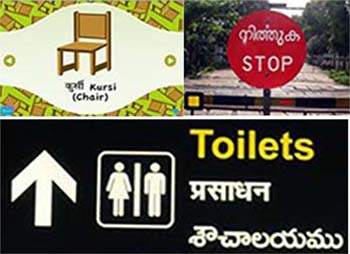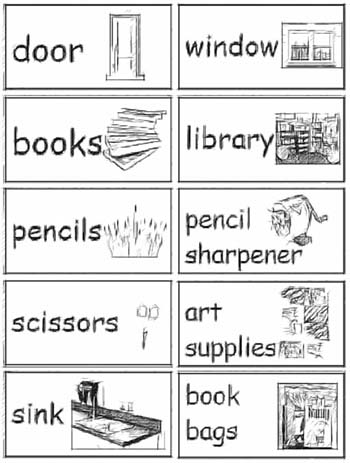Use 'Print preview' to check the number of pages and printer settings.
Print functionality varies between browsers.
Printable page generated Friday, 26 April 2024, 12:57 PM
TI-AIE: The learning environment
What this unit is about
The focus in this unit is on environmental print and the print-rich environment of your classroom.
Students take their first steps towards literacy when they become aware that the print they see around them carries meaning. ‘Environmental print’ at home and in the community is often the first writing that students learn to read. This is the writing that is part of everyday life – writing we see all around us on signs, tickets, newspapers, packets and posters. When students come to school, they see new forms of environmental print: charts, lists, schedules, labels and all kinds of reading material. Teachers can make good use of these community and school resources to teach English.
The activities in this unit give you opportunities to improve the print environment of your classroom – whatever your starting point may be – and to improve and practise your English with students. Adapt the activities based on your professional needs and the needs of your students.
What you can learn in this unit
- To use local print resources for English literacy.
- To plan print-based activities in English lessons.
- To make interactive English literacy resources.
1 What is environmental print?
Start by looking at the term ‘environmental print’, its meaning and how it can support students’ learning.
Environmental print is often the first writing that students learn to read with enjoyment and enthusiasm. For instance, many students will know that the words in Figure 1, on a blue background, and this shape, mean a nice treat of ice cream. Can you think of other signs like this?
Figure 1 Mother Dairy logo
Most students start school with some knowledge about print and also some knowledge about English. In school they are exposed to new, different forms of writing: charts, lists, names, schedules, labels and all kinds of reading material.
At little or no cost, you can make a lively, visual classroom where students are exposed to a range of print. The walls and spaces of your classroom can be a creative communicational environment where you display and teach with a variety of school, community and home writing.
Activity 1: From signs and symbols to reading
Have you ever been in a foreign country, or to a different state in your own country, where you could not read the local language? How did you figure out where to go, what to do or what the shop signs and street posters meant? Did you sometimes get it wrong? Were you pleased when you worked it out? Did you use your home language knowledge to work out the new language?
Your students who cannot yet read are in this ‘foreign country’. They see letters and words written on different things in different places: boxes in the market, labels on clothing, billboards and traffic signs on the road, books or pamphlets in the home, announcements in the temple or the mosque, and text on mobile phones. They know that these marks and symbols carry information. They begin to 'read' the information using clues that surround the words: pictures, symbols, colours, shapes, where the writing is located and what people do with the writing.
Look at Figure 2. Think about how the words and images work together, and the colours you also might see with the words and shapes. If you could not read any written language, how would you know what these signs say?
Figure 2 Three signs.
If you did not know any Hindi or any English, you could still work out the meaning of the signs by using your life experience and your knowledge of the world. Students are building their knowledge about language and the world.
Many urban students can ‘read’ the symbols that identify corporations and brands. In the same way, rural students know the symbols for ‘railway crossing’ or ‘bus stop’. The environmental print that students can ‘read’ is influenced by their life experiences so far, where they live, and what happens around them at home and in the community.
2 Recognising environmental print
Recognising environmental print:
- makes students feel successful at ‘reading’
- motivates them to read more
- lays the foundation for reading words, sentences and longer texts.
But exposure to environmental print does not automatically lead students to read. Students may initially learn to recognise words in specific environments but then do not recognise the same words when these are out of context.
Activity 2: Making the transition
Look at the two pictures in Figure 3. Both pictures contain the word ‘fish’. One has clues; the other does not. Which ‘fish’, do you think, is easier for a young student to read, and why would it be easier? Discuss your ideas with other teachers.
Figure 3 The importance of context.
Pause for thought If you have words displayed on the walls of your classroom, are these words in isolation or do they have ‘clues’? |
3 Introducing environmental print into the classroom
What print resources can your students bring into the classroom? In Case Study 1, a new teacher takes steps to create a print-rich environment with her students.
Case Study 1: Ms Pillai develops the classroom environment
When Ms Pillai first became a primary school teacher, she was given Class I. Most of the students were first-generation students.
I felt I had full responsibility for the students’ literacy development. Fresh from teacher training, I knew that every teacher is entitled to Rs. 500 to purchase teaching and learning materials (TLM). I bought different coloured paper, marker pens, Post-it notes, glue, a few pairs of scissors, some charts and some National Book Trust story books, which are of good quality and also inexpensive.
Then I sought the help of my students, my most important resource, in the teaching and learning process. I asked them to get any print materials they could lay their hands on. I was amazed by what they brought into the classroom: film posters, advertisements, recycled magazines and newspapers, food packets, festival greeting cards, political leaflets, mobile phone instructions, computer and printer instructions, and health announcements.The print material that students brought also reflected their interests, things they wanted to know or read, and things they were curious about [such as the examples in Figure 4].

With these resources, we began to build the classroom’s print environment.
Students used scissors to cut letters and words from the print material they had brought in. While they built words and short sentences with my help in Hindi, I wrote out the English equivalents. We compared the same words in the two different languages, and in different scripts:
| house | ghar | घर |
| teeth | dant | दाँत |
| father | baap | बाप |
| mother | maa | मां |
This activity was also good for the development of students’ fine motor skills and eye-hand coordination. We also copied out letters and words in English and Hindi, and displayed these with drawings to illustrate the words. We made a word wall of our favourite and most interesting words.
All this was very encouraging for me as a new teacher. My students learned that words are symbols for people, places and things in their world. They increased their vocabulary and they developed confidence as bilingual students. I also gained more confidence in using English in the classroom.
4 Teachers talk about environmental print
We asked six elementary teachers in government schools to tell us how they use print material in their classrooms. This is what they said:
- ‘My students mark their attendance on a chart themselves, so they must read their names in English and tick their attendance. They learn to recognise their names in English and sign their names on the chart. In addition to language development, this helps us to prevent absenteeism because students are motivated to record their attendance.’
- ‘For different curriculum topics, I write what the students say on large sheets of paper. I write down their exact words, and they write their names in English to show that it is all their own words. This lets me see what they know and understand. I display the writing on the classroom walls, and we read it together. I see students reading their words to each other and to parents when they come into school.’
- ‘I label items in my classroom (chair, table, pencils) and even outside the classroom (door, gate, road, entrance, office) in Hindi and English. Even in the school toilet, I displayed a sign that reminded students to flush and wash their hands. From this, I was able to talk to students about how to fight germs, infections and disease.’
- ‘We don’t stop at the school – we want to add literacy to students’ homes. The students and I talked about places in the home that could be labelled (kitchen, pot, shrine, window, chair) and what kinds of messages could be inside a home, such as “Take off your shoes” and “Wash your hands before eating”. We made labels in English and in Hindi. Students took the labels home. One mother came into school to tell me that she had bought a garbage bin for her house because one of the labels her daughter brought home was “Dustbin” with the message “Throw your garbage in a bin”. We know from experience that this type of activity done in the home and at school can encourage parents to read with their students.’
- ‘I teach at a government school in a small village. I encourage my students to make greeting cards for their family with simple messages in English, which they read out at home. Parents have been highly appreciative of this and felt proud that their children could write and read in English.’
- ‘I create “functional print” for all classroom communication and routines; for instance, a daily schedule. I make sure to refer to it and encourage students to notice it. This can help them to manage their own learning. On the board I write out the day of the week and the month, names of visitors to the school, rules for behaviour and the morning message. It is important to encourage the students to read these daily and to talk about them.’
- ‘I teach in a rural school and my classroom is small. One wall contains the board and the other walls have windows and the door. Display boards or tables would take up too much space, so I put students’ work on the wall just outside the classroom door. Inside, I attach students’ work to string using clothes pegs, paper clips, tape or sometimes thorns. The string is like a washing line across the classroom. Decorating the room with writing and drawing makes the classroom more attractive and welcoming.’
- ‘I teach in a multigrade, multilevel class. Once a month we have a “translation workshop” for the older students. They bring in simple print materials – mostly wedding invitation cards from their homes. Working in groups, they translate the content of the card into English, with my help. I take these home and, with my neighbour’s help, edit the translations. We then display both the original invitation cards and the edited translated versions on the display board for younger students to read.’
Pause for thought
|
Video: Involving all |
5 Planning to use environmental print in your classroom
Activity 3: Look around your classroom – a planning activity
Look around your classroom. If you could make one or two changes to introduce environmental print, what would the changes be? How could these changes improve teaching and learning, do you think?
Are there practical steps you could take to make these changes?
Think of ways of making simple display boards using easily available materials such as discarded cartons, gunny bags and used packaging materials.
See Resource 2, ‘Involving all’ , to learn more about the value of including all students in the classroom environment.
Activity 4: Classroom labels
If you have a large class, you can do this activity with a different group of students each day.
For older students who have some experience of English, adapt this activity so that the cards are in English only and have the students write the cards themselves.
The resources you will need include card, pens and tape.
- Prepare some cards in two languages (Hindi and English, or home language and English) but leave some cards blank so students can contribute their ideas.
- Tell students you need their help to put the right label on the right item or shelf.
- Tell the students you will be learning and practising English together.
- Show the students the labels you have already made in English and one other language, for instance: ‘desk’, ‘window’, ‘chair’. Read the label to the students in the home language/Hindi and in English. Practise the words in English together.
- Ask students where the labels should be placed; for instance, on the bookshelf, at the door, on the table, on the desk.
- Ask the students what else could be labelled around the classroom, or where a sign could be placed to help people visiting the school.
- As you write out each label or sign, say the names of the letters and the words.
- Practise saying the words together in both languages.
Examples of classroom labels are shown in Figure 5.
Figure 5 Classroom labels.
When you label the classroom, you can refer to the words throughout the day as you teach. Ask students to find and point to the words that you use. Have students use the words in conversation with you and with each other, for instance:
- ‘Shusheela, please bring the books.’
- ‘Yes, I will bring the books.’
- ‘Thank you. Mohan, please go and open the door.’
- ‘Yes, I will open the door.’
Labelling the classroom will develop students’ reading, oral and listening skills in English. Your formative assessments will be based on oral questions and responses, and will help you identify areas where students need additional practice.
Activity 5: Interactive word wall
Read about the variety of word wall topics in Resource 1. Look at the pictures and think about what is possible and practical for your classroom.
Choose a topic to create a word wall in your classroom. Discuss your ideas with your fellow teachers or your head teacher.
Students should be able to see and touch the words and sentences that are displayed in the classroom. Daily word wall activities should be frequent, short and fun – and not just at specific times of the day. Encourage interaction with cheers and chants for new words of the week, as well as discussions that draw students’ attention to how words look and sound.
Remember: a teacher’s job is not finished when writing goes up on the classroom walls. You need to help students to use these resources. Daily word wall activities do not need to be long teaching sessions; they might be time to read and say the day of the week, read out students’ names, or read and say special weekly words. Integrate the word walls into your lesson plans and make opportunities for students to refer to the word walls independently for creative writing, spelling and vocabulary. Using the word wall frequently during the school day will also help you to feel more confident about using English in the classroom.
6 Summary
This unit has focused on environmental print. This is the writing we interact with in our day-to-day life. It is writing that everyone can see, share and talk about, so it is a strong resource for teaching and learning. A ‘print-rich’ classroom can build students’ reading confidence. Students who learn to use contextual clues (such as pictures, location, objects, colours or diagrams) to make sense of writing in their environment will be able to make the transition to ‘real’ reading more easily.
Interactive displays of print, teaching materials and examples of students’ writing can reinforce learning and encourage them to take pride in their work. Displaying students’ own writing will not only motivate them but also generate easy, ready-to-use texts in English that other students can also read with or without the teacher. Displays are also a good way to decorate your classroom and ‘show off’ your practice. When parents come into your classroom they will immediately see the learning that is going on.
We hope you have enjoyed the readings and practical activities in this unit, and that you have developed ideas to create an interactive, print-rich environment in your classroom, as well as developing confidence in using English.
Other Elementary English teacher development units on this topic are:
- Mark-making and early writing
- Developing and monitoring writing.
Resources
Resource 1: Word wall topics
When a collection of words is displayed in a classroom in an organised way, it is often called a ‘word wall’. This display can be used as an interactive resource for reading, writing, vocabulary development, spelling patterns, word/picture association and referencing. Word walls can be categorised into different themes such as colours, names, daily routine words, help words and number names, words with the same starting or ending letters, and word families.
Word walls are a low-cost way for any teacher to help students to develop and reinforce their English vocabularies in any topic, from science to art. There is no limit to the word walls you can develop. The size and shape of your word wall will depend on the size and shape of your classroom. You can use the chalkboard, chart paper, paper and string, or simply the walls inside and outside your classroom.
Look at Figures R1.1–1.3 and think about what is possible in your classroom.
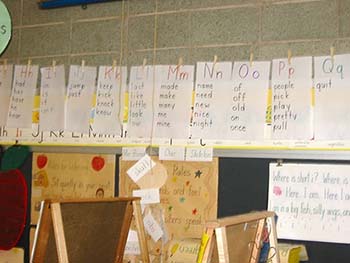
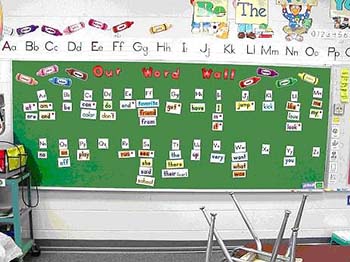
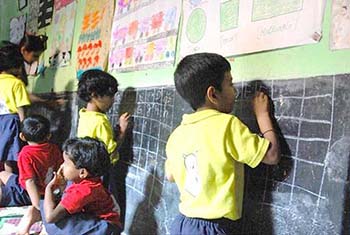
High-frequency word wall
Primary grade texts are comprised primarily of high-frequency words – these are words that occur often in conversation or in books. (Examples are shown in Figure R1.4.) Students learning English can get a boost in their language skills when they recognise these words quickly and easily.
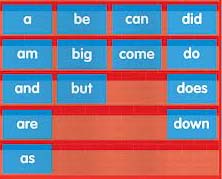
Literature word wall
Word walls can be created to help older students during literature study. The teacher should select key words, new vocabulary words or characters’ names from the piece of literature that the class will be reading. As these words are encountered in the text, they should be written on paper and posted together in a central location in the classroom. The wall will help students to learn these new words and give easy access to important information when discussing the book in class.
A literature word wall can also have pictorial descriptions of the story’s main plot or its characters (Figure R1.5). These pictures can be associated with one line about the story, the characters’ names or anything related to the story that is significant and memorable. A word wall that displays words from a particular story should also include the names of the author, illustrator and translator (if any).
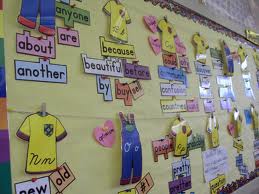
Seasonal word wall
Elementary-grade classrooms study units around the seasons of the year. Thus, ‘seasons’ can be used as a context to develop a word wall (Figure R1.6). Important key words focusing on a particular season can be used to create a seasonal word wall.
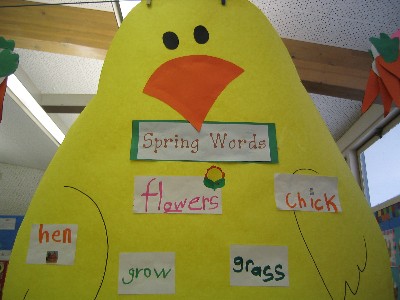
As each word is introduced, it should be written on a piece of paper and posted in the classroom. Over time, a collection of words related to the season will develop. For instance, a wall titled ‘These days (in summer) the markets are full of …’ can display students’ observations regarding seasonal fruits, seasonal vegetables and summer clothing, or other items such as cold drinks, juices, ice creams, umbrellas, sun hats, sunglasses, etc.
At the end of the season the words can be moved to another part of the classroom. As the seasons progress, students will be able to look back at the collections of words associated with each season to see the commonalities and differences between each time of the year.
A word wall may also be used as a resource for other activities. For instance, students could create a new poem or story using words written on an existing word wall. Doing this will give them an opportunity to use the words for different purposes.
Starting the year with young or pre-literate students
Start the school year and the word wall by getting to know your class. Each day, write the names of five students until all the names are on the wall. Spend some time looking at the five names each day, and focus on the sound and letter patterns in the names. For example, if the name ‘Chunni’ is added, you can spend time looking at the ‘ch’ sound and talking about other words that have the same sound.
You can compare new names to the names already on the wall. For instance, is the ‘i’ at the end of Chunni's name different from or similar to the ‘i’ at the end of ‘Kadambari’? In this way, students have their first lessons in letter, sound and spelling patterns.
For any topic, add five words each week to the word wall. You can introduce all five new words on Monday. A useful resource is to place all five words in a pocket chart before the students arrive on Monday morning. The students will want to investigate the new words in the pocket chart as they come into the classroom. Let them handle the words in the pocket chart and try to read them. Sometimes, students will read the new words before ‘word wall time’ in the class. This can lead to interesting discussions and learning.
Writing word wall
Writers, especially those in the younger grades, often have difficulty retrieving a wide variety of vocabulary to use in their writing. You can help spark their memories by posting lists of words on the wall. The list can be general or specific. If your class is studying a particular mode of writing, you can post words that are often used in that type of writing. For example, when the class is working on compare-and-contrast writing, words such as ‘similar’, ‘different’, ‘same’ and ‘opposite’ could be posted on the word wall to remind students to use these in their writing.
Spelling word wall
A spelling word wall should be organised alphabetically to help students locate the words as they need to spell them. The wall should include words that the class encounters and wants to learn to spell. Common spelling errors in writing, key words from literature, weekly spelling lists and even students’ names can be added to the word wall. The wall should always be a ‘work in progress’. Words should be added as you and your class decide they need to learn to spell them. You can cover the spelling word wall with blank paper during spelling tests.
Parts of speech word wall
Sometimes we all struggle to understand which grammatical part of speech a word fits into in an English sentence. To help students understand basic concepts of English grammar, teachers can create a word wall organised by part of speech (i.e. nouns, verbs, adjectives, adverbs). As students learn or study new words, they can add each to the correct grammatical part of speech. If you are teaching students how to add interest to their writing by using adjectives, you can make a word wall of ‘amazing adjectives’. As the class reads stories and poetry, ask the students to listen and look for interesting describing words and add these adjectives to the special word wall. You can have a similar wall for ‘vivid verbs’.
Textbook unit/chapter word wall
The word wall can be an aid for a particular unit or chapter of study. You and your students can select key terms from the unit or chapter, and write them on paper. As each word is introduced, it should be added to the wall alphabetically. At the end of the unit or chapter, the word wall can come down. This is a good way to incorporate a word wall into your classroom if you have limited space. Table R1.1 is an example of this kind of word wall.
Table R1.1 Word wall for ‘The Magic Garden’ (Marigold Class III textbook).
Aa after again against all | Bb birds bread | Cc cans students
| Dd danced dear dig dreaming dress | Ee | Ff fairy flowers | Gg garden gardeners ground | Hh happily help high |
Ii indeed | Jj | Kk | Ll laughing little love | Mm magic morning most | Nn next nothing
| Oo | Pp playground |
quite | Rr roots roses running | Ss school singing students sunflowers sunny sunshine | Tt talking tall thirsty tiny
| Uu | Vv very
| Ww wall watering wings | Xx |
| Yy | Zz |
Resource 2: Involving all
What does it mean to ‘involve all’?
The diversity in culture and in society is reflected in the classroom. Students have different languages, interests and abilities. Students come from different social and economic backgrounds. We cannot ignore these differences; indeed, we should celebrate them, as they can become a vehicle for learning more about each other and the world beyond our own experience. All students have the right to an education and the opportunity to learn regardless of their status, ability and background, and this is recognised in Indian law and the international rights of the child. In his first speech to the nation in 2014, Prime Minister Modi emphasised the importance of valuing all citizens in India regardless of their caste, gender or income. Schools and teachers have a very important role in this respect.
We all have prejudices and views about others that we may not have recognised or addressed. As a teacher, you carry the power to influence every student’s experience of education in a positive or negative way. Whether knowingly or not, your underlying prejudices and views will affect how equally your students learn. You can take steps to guard against unequal treatment of your students.
Three key principles to ensure you involve all in learning
- Noticing:Effective teachers are observant, perceptive and sensitive; they notice changes in their students. If you are observant, you will notice when a student does something well, when they need help and how they relate to others. You may also perceive changes in your students, which might reflect changes in their home circumstances or other issues. Involving all requires that you notice your students on a daily basis, paying particular attention to students who may feel marginalised or unable to participate.
- Focus on self-esteem:Good citizens are ones who are comfortable with who they are. They have self-esteem, know their own strengths and weaknesses, and have the ability to form positive relationships with other people, regardless of background. They respect themselves and they respect others. As a teacher, you can have a significant impact on a young person’s self-esteem; be aware of that power and use it to build the self-esteem of every student.
- Flexibility: If something is not working in your classroom for specific students, groups or individuals, be prepared to change your plans or stop an activity. Being flexible will enable you make adjustments so that you involve all students more effectively.
Approaches you can use all the time
- Modelling good behaviour:Be an example to your students by treating them all well, regardless of ethnic group, religion or gender. Treat all students with respect and make it clear through your teachingthat you value all students equally. Talk to them all respectfully, take account of their opinions when appropriate and encourage them to take responsibility for the classroom by taking on tasks that will benefit everyone.
- High expectations:Ability is not fixed; all students can learn and progress if supported appropriately. If a student is finding it difficult to understand the work you are doing in class, then do not assume that they cannot ever understand. Your role as the teacher is to work out how best to help each student learn. If you have high expectations of everyone in your class, your students are more likely to assume that they will learn if they persevere. High expectations should also apply to behaviour. Make sure the expectations are clear and that students treat each other with respect.
- Build variety into your teaching:Students learn in different ways. Some students like to write; others prefer to draw mind maps or pictures to represent their ideas. Some students are good listeners; some learn best when they get the opportunity to talk about their ideas. You cannot suit all the students all the time, but you can build variety into your teaching and offer students a choice about some of the learning activities that they undertake.
- Relate the learning to everyday life:For some students, what you are asking them to learn appears to be irrelevant to their everyday lives. You can address this by making sure that whenever possible, you relate the learning to a context that is relevant to them and that you draw on examples from their own experience.
- Use of language:Think carefully about the language you use. Use positive language and praise, and do not ridicule students. Always comment on their behaviour and not on them. ‘You are annoying me today’ is very personal and can be better expressed as ‘I am finding your behaviour annoying today. Is there any reason you are finding it difficult to concentrate?’, which is much more helpful.
- Challenge stereotypes:Find and use resources that show girls in non-stereotypical roles or invite female role models to visit the school, such as scientists. Try to be aware of your own gender stereotyping; you may know that girls play sports and that boys are caring, but often we express this differently, mainly because that is the way we are used to talking in society.
- Create a safe, welcoming learning environment:All students need to feel safe and welcome at school. You are in a position to make your students feel welcome by encouraging mutually respectful and friendly behaviour from everyone. Think about how the school and classroom might appear and feel like to different students. Think about where they should be asked to sit and make sure that any students with visual or hearing impairments, or physical disabilities, sit where they can access the lesson. Check that those who are shy or easily distracted are where you can easily include them.
Specific teaching approaches
There are several specific approaches that will help you to involve all students. These are described in more detail in other key resources, but a brief introduction is given here:
- Questioning:If you invite students to put their hands up, the same people tend to answer. There are other ways to involve more students in thinking about the answers and responding to questions. You can direct questions to specific people. Tell the class you will decide who answers, then ask people at the back and sides of the room, rather than those sitting at the front. Give students ‘thinking time’ and invite contributions from specific people. Use pair or groupwork to build confidence so that you can involve everyone in whole-class discussions.
- Assessment:Develop a range of techniques for formative assessment that will help you to know each student well. You need to be creative to uncover hidden talents and shortfalls. Formative assessment will give you accurate information rather than assumptions that can easily be drawn from generalised views about certain students and their abilities. You will then be in a good position to respond to their individual needs.
- Groupwork and pair work:Think carefully about how to divide your class into groups or how to make up pairs, taking account of the goal to include all and encourage students to value each other. Ensure that all students have the opportunity to learn from each other and build their confidence in what they know. Some students will have the confidence to express their ideas and ask questions in a small group, but not in front of the whole class.
- Differentiation: Setting different tasks for different groups will help students start from where they are and move forward. Setting open-ended tasks will give all students the opportunity to succeed. Offering students a choice of task helps them to feel ownership of their work and to take responsibility for their own learning. Taking account of individual learning needs is difficult, especially in a large class, but by using a variety of tasks and activities it can be done.
Additional resources
- RVEC Bangalore: http://www.rvec.in/
- Teachers of India classroom resources: http://www.teachersofindia.org/ en
References
Acknowledgements
Except for third party materials and otherwise stated below, this content is made available under a Creative Commons Attribution-ShareAlike licence (http://creativecommons.org/ licenses/ by-sa/ 3.0/). The material acknowledged below is Proprietary and used under licence for this project, and not subject to the Creative Commons Licence. This means that this material may only be used unadapted within the TESS-India project and not in any subsequent OER versions. This includes the use of the TESS-India, OU and UKAID logos.
Grateful acknowledgement is made to the following sources for permission to reproduce the material in this unit:
Figure 1: Mother Dairy trademark, http://www.motherdairy.com.
Figure 2: chair, http://appfinder.lisisoft.com/ app/ my-first-100-words-in-hindi.html; toilet sign, http://www.ispeakhindi.com/ 2009/ 04/ 08/ airport-signs-in-india/; stop sign, http://signs.kiev.ua/;
Figure 3: left: http://www.etsy.com/; right: http://giedd-kindergarten.blogspot.co.uk/.
Figure 4: left: photo of Times (India) by Aviva West (Flickr); middle: photo courtesy of the Medical Materials Clearinghouse at the Johns Hopkins University Bloomberg School of Public Health/Center for Communication Programs; right: Barfi film poster, http://infinitymoviez.blogspot.co.uk/.
Figure 5: http://www.thecurriculumcorner.com/ 2012/ 07/ 24/ read-the-room-classroom-labels/.
Figure R1.1: http://tcnj.pages.tcnj.edu/
Figure R1.2: http://nicadez.blogspot.co.uk/ 2013/ 02/ the-importance-of-word-walls.html
Figure R1.3: http://usf.vc/ updates/ driving-change-through-rural-education-in-india/.
Figure R1.5: http://schools.cbe.ab.ca/ b233/ showcase.htm.
Figure R1.6: http://www.kinderbykim.com/.
Every effort has been made to contact copyright owners. If any have been inadvertently overlooked the publishers will be pleased to make the necessary arrangements at the first opportunity.
Video (including video stills): thanks are extended to the teacher educators, headteachers, teachers and students across India who worked with The Open University in the productions.

